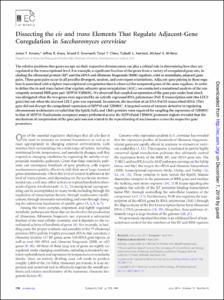Please use this identifier to cite or link to this item:
http://hdl.handle.net/20.500.12164/148| Title: | Dissecting the cis and trans elements that regulate adjacent-gene coregulation in Saccharomyces cerevisiae |
| Authors: | Arnone, James T. Arace, Jeffrey R. Soorneedi, Anand R. Citino, Teryn T. Kamitaki, Tadashi L. McAlear, Michael A. |
| Keywords: | Biology |
| Issue Date: | 2014 |
| Publisher: | American Society for Microbiology |
| Citation: | Arnone, J. T., Arace, J. R., Soorneedi, A. R., Citino, T. T., Kamitaki, T. L., McAlear, M. A. (2014). Dissecting the cis and trans elements that regulate adjacent-gene coregulation in Saccharomyces cerevisiae. Eukaryotic cell, 13(6), 738-48. |
| Abstract: | The relative positions that genes occupy on their respective chromosomes can play a critical role in determining how they are regulated at the transcriptional level. For example, a significant fraction of the genes from a variety of coregulated gene sets, including the ribosomal protein (RP) and the rRNA and ribosome biogenesis (RRB) regulons, exist as immediate, adjacent gene pairs. These gene pairs occur in all possible divergent, tandem, and convergent orientations. Adjacent-gene pairing in these regulons is associated with a tighter transcriptional coregulation than is observed for nonpaired genes of the same regulons. In order to define the cis and trans factors that regulate adjacent-gene coregulation (AGC), we conducted a mutational analysis of the convergently oriented RRB gene pair MPP10-YJR003C. We observed that coupled corepression of the gene pair under heat shock was abrogated when the two genes were separated by an actively expressed RNA polymerase (Pol) II transcription unit (the LEU2 gene) but not when the inserted LEU2 gene was repressed. In contrast, the insertion of an RNA Pol III-transcribed tRNA (Thr) gene did not disrupt the coregulated repression of MPP10 and YJR003C. A targeted screen of mutants defective in regulating chromosome architecture revealed that the Spt20, Snf2, and Chd1 proteins were required for coupling the repression of YJR003C to that of MPP10. Nucleosome occupancy assays performed across the MPP10 and YJR003C promoter regions revealed that the mechanism of corepression of the gene pair was not related to the repositioning of nucleosomes across the respective gene promoters. |
| URI: | http://doi.org/10.1128/EC.00317-13 http://hdl.handle.net/20.500.12164/148 |
| ISSN: | 1535-9786 |
| Appears in Collections: | Biology |
Files in This Item:
| File | Description | Size | Format | |
|---|---|---|---|---|
| 738.full.pdf | Article | 2.44 MB | Adobe PDF |  View/Open |
Items in DSpace are protected by copyright, with all rights reserved, unless otherwise indicated.
